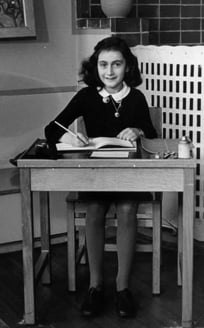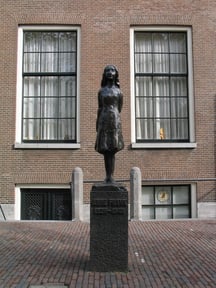In 1945, Otto Frank came to Amsterdam after surviving the torments and traumas of Auschwitz. His return home confirmed the unimaginable. He was the sole survivor of his family. His daughters, including 15-year-old Anne, who had been separated from him and transported to Bergen-Belsen, had died. But soon he was greeted by a glimmer of hopeful news: Miep Gies, a secretary and aid to the Franks during their hiding, had preserved Anne’s diary.
 The day when the eight people in the Secret Annex were arrested by Nazis, on August 4, 1944, Gies collected the papers scattered across the floor. The papers made up Anne Frank’s diary, which spanned the dates June 12, 1942 to August 1, 1944. Out of respect for her privacy, Gies did not read the diary, keeping the pages she found safe and untouched until war’s end.
The day when the eight people in the Secret Annex were arrested by Nazis, on August 4, 1944, Gies collected the papers scattered across the floor. The papers made up Anne Frank’s diary, which spanned the dates June 12, 1942 to August 1, 1944. Out of respect for her privacy, Gies did not read the diary, keeping the pages she found safe and untouched until war’s end.
Otto did not take to reading them immediately, either. But soon, he began translating passages from Dutch and mailing them to his relatives in Switzerland. Many were convinced that the diary exhibited talented and illuminating writing, and that it would be best to publish it for the world to see.
But the text needed editing. As she left it, Anne Frank created two versions of her own diary. The first, called version a in The Diary of Anne Frank: The Critical Edition (1987), consisted of her original, raw reflections as she began writing in 1942.
Then, in 1944, a Dutch exile named Gerrit Bolkestein sent a radio broadcast from London expressing a desire to publish accounts of the war during the German occupation, putting a special emphasis on diaries and letters. Anne was inspired by this, and began editing her diary by rewriting passages, recording memories she neglected, excising sections, and giving pseudonyms to the “characters” involved, including herself, whom she referred to as Anne Aulis, and later Anne Robin. This revised portion is known as version b.
 Constrained by publisher demands for length, Otto cut sections of the diary. He excised mundane passages. He also took out passages dealing with sex, including an oft-challenged section in which Anne, with normal youthful curiosity and guiltlessness, explores and catalogs her genitalia. Just as important to remove for Otto were parts critical of the dead, including those concerning Anne's mother and the family the Franks shared the annex with, the Van Pels.
Constrained by publisher demands for length, Otto cut sections of the diary. He excised mundane passages. He also took out passages dealing with sex, including an oft-challenged section in which Anne, with normal youthful curiosity and guiltlessness, explores and catalogs her genitalia. Just as important to remove for Otto were parts critical of the dead, including those concerning Anne's mother and the family the Franks shared the annex with, the Van Pels.
Out of these two versions, Otto created the first published form of the diary, known as version c, which became well-known to the world as A Diary of a Young Girl.
Otto Frank died in 1980, and willed Anne Frank’s manuscript to the Netherlands State Institute for War Documentation. The diary had been hounded by accusations of forgery since publication, and the institute confirmed its authenticity, publishing The Critical Edition in 1987, which included versions a, b, and c, and supplementary material about the Franks and the conditions of their hiding and their suffering in the concentration camps.
Many other versions of the book have been made since, typically in the interest of abridging or censoring the text to make it more suited for students and young audiences. But there is far less that we needed to be protected from in the diary of Anne Frank than there is to be educated and enriched by.









